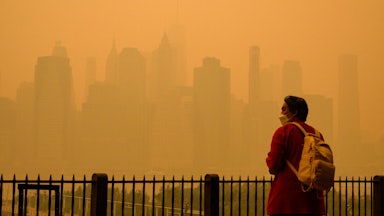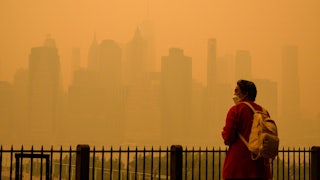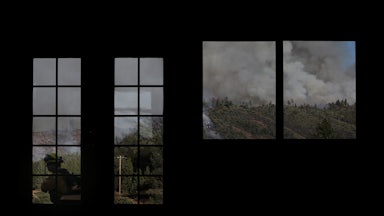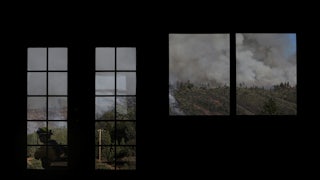In early June, as wildfires in Canada raged over record amounts of acreage and blew smoke across the Eastern Seaboard, local news in Buffalo, New York, took photos of the haze covering the city. The health department of Erie County issued a warning urging people to stay indoors and provided free N-95 masks for residents.
Ironically, just a few years ago, the mayor of Buffalo had declared the city a “climate refuge” in his State of the City address. Buffalo’s tourism website, Be in Buffalo, has an entire section devoted to the idea, including a YouTube video advertising the city’s access to fresh water and use of renewable energy.
A large body of recent research has shown that as the planet continues to warm, certain places in the United States will experience fewer severe impacts of climate change than others. Over the past few years, a deluge of corresponding media articles has told readers that the Upper Midwest or the Northeast—places such as Duluth, Minnesota, or Buffalo—will become climate change “havens,” where people alarmed by increasingly powerful hurricanes, expansive wildfires, or boiling heat could move to stay safe.
But now that we’ve seen orange skies in New York and poor air quality in the Midwest because of the wildfires in Canada, do we have to rethink how we view these regions? Can places like Buffalo really be called “refuges” if residents will need to stay inside regularly thanks to smoke?
Jesse Keenan, a professor of sustainable real estate at Tulane University, has been one of the leading voices arguing that these regions are your best bet if you’re trying to avoid the worst effects of climate change. He told me that the recent smoke from the wildfires hasn’t changed his mind. Despite how this topic is sometimes framed in the media, he said, the point was never that these regions would completely avoid the effects of climate change.
“I don’t think the forest fires really change much,” Keenan told me. “Nowhere is safe. It’s all about tradeoffs.”
Keenan said these regions have various benefits, depending on where you go, but they generally include access to fresh water, a more moderate climate, and general affordability. If the wildfires were causing smoke to blow in on a nearly constant basis, then, Keenan said, that could change how people viewed these places—but that’s not the situation we’re currently in. However, orange skies and bad air are expected to happen more in the future on the East Coast—thanks, in part, to the severity of wildfires increasing with climate change.
“There’s gonna be more forest fires, and there will be more smoke,” Keenan says.
Linda Shi, an assistant professor of city and regional planning at Cornell University, also doesn’t think this month’s catastrophic smoke changes the calculus surrounding normally smoke-free regions that much. She said these things are hard to study, and we just don’t know how these events are going to affect how people think about these places—but the apocalyptic skies probably haven’t had a major effect at this point in time.
“Even the places we consider to be more resilient, climate affects them too,” Shi said. “Even if it’s relatively better than some other parts of the world, it’s still a significant impact for them that they might not be prepared for.”
Shi said most people don’t have climate at the top of their mind when they’re considering where they’re going to move in the first place. This is borne out by data: Miami, after all, is one of the fastest-growing cities in the country, despite the real and urgent risks presented by sea level rise.
Shi said there’s a “big disconnect” between where people might logically want to move for climate reasons and where they actually end up when they decide it’s time to relocate.
“Even when people are pushed out of a place because of a climate-related disaster, the pull factors of where they go tends to be much more diverse than just a climate reason,” Shi told me. “Probably the two greatest factors of what makes people move to a certain place are going to be jobs and family.”
Shi told me that comparing the Environmental Protection Agency climate resilience index, which shows which U.S. counties are the most and least climate resilient, to a map of where the population is increasing or decreasing shows that people are generally moving to some of the least resilient places. She said if major businesses start to move for climate reasons, then that migration pattern may start to change. “One of the biggest draws of migration is employment, so the real question is at what point will major employers move? Because their move is going to significantly affect where people choose to migrate for purposes of work,” Shi said.
That said, some people are definitely thinking ahead. Shi is working on a research project revolving around climate resilience and climate migration in Buffalo. She’s noticed some people are buying up tons of property, and she said she believes they’re expecting an influx of climate migrants—perhaps in an attempt to turn a profit on climate migration.
Not everyone can afford to pick up and move because of the threats of climate change; there are clear equity issues here. People who want to move might have trouble selling their homes in a place people no longer deem as safe. Studies have shown that evacuees from climate crises like Hurricane Katrina struggled in their new cities after short-term aid evaporated. As Keenan has found in his research, wealthier people are also driving what’s known as climate gentrification: when a less wealthy area becomes more expensive to live in because people with money to spend are buying up property in places that seem more climate-resilient. For many Americans, poverty poses just as much of a danger as hurricanes or wildfires.
For now, it seems the Upper Midwest and the Northeast are still probably the best places to consider for people thinking about (and who have the money for) relocating for climate reasons. Nowhere in the U.S. will be truly safe from the devastating sociologic and economic impacts of what’s going to happen if we keep burning fossil fuels—but in these regions, at least, it’s unlikely that the skies will constantly be orange anytime in the near future. See you in Duluth.










